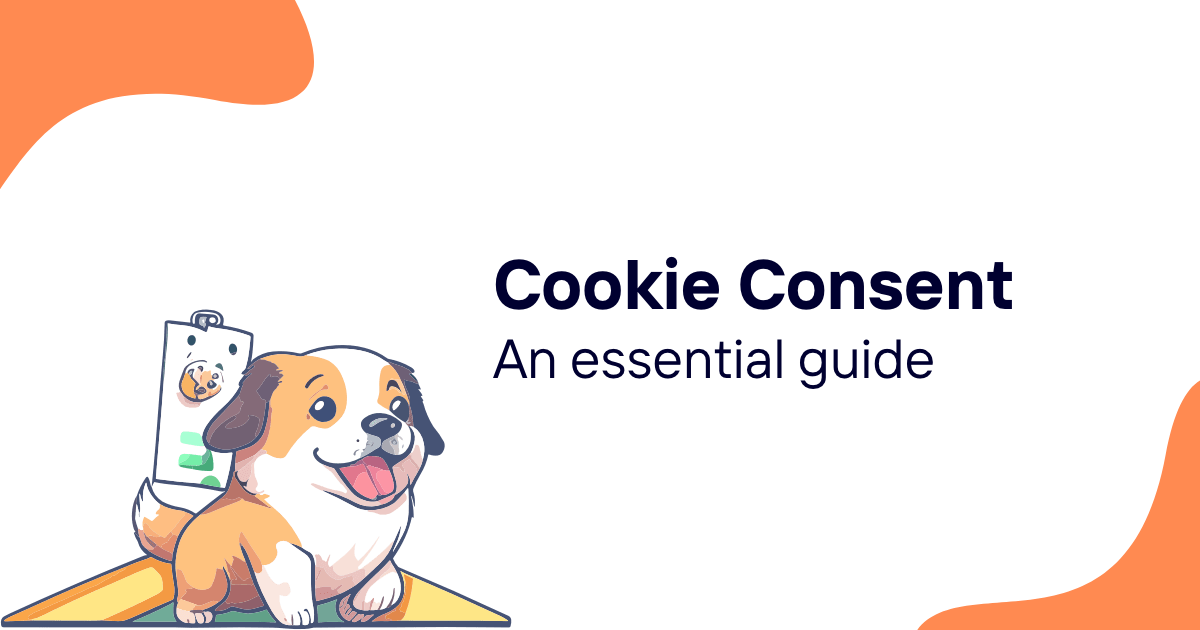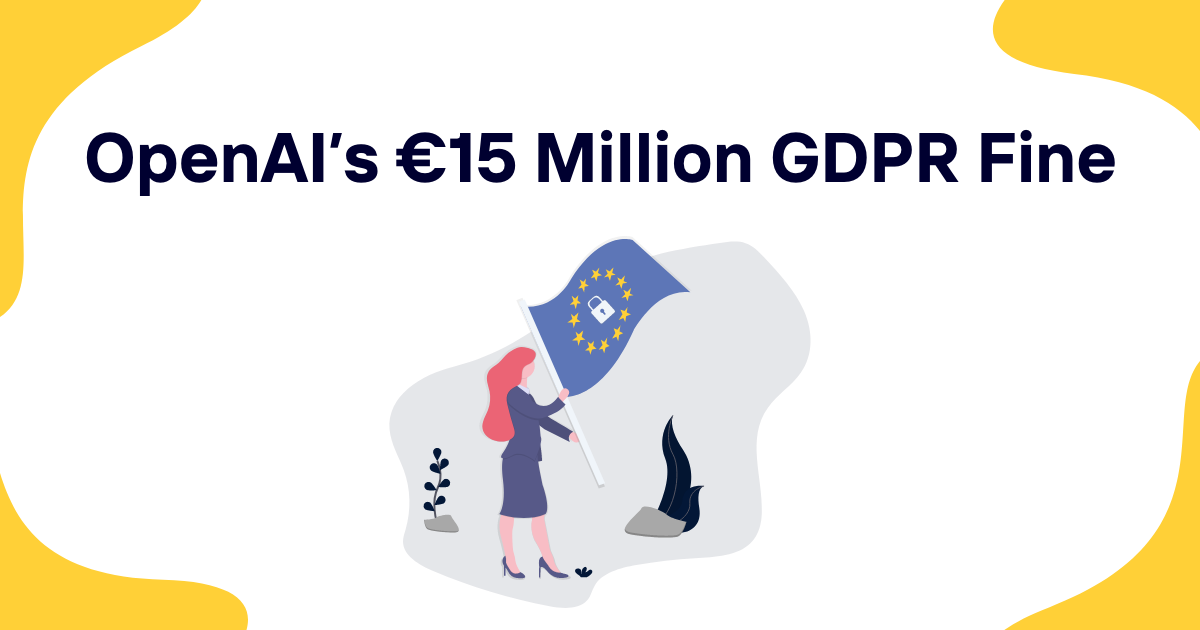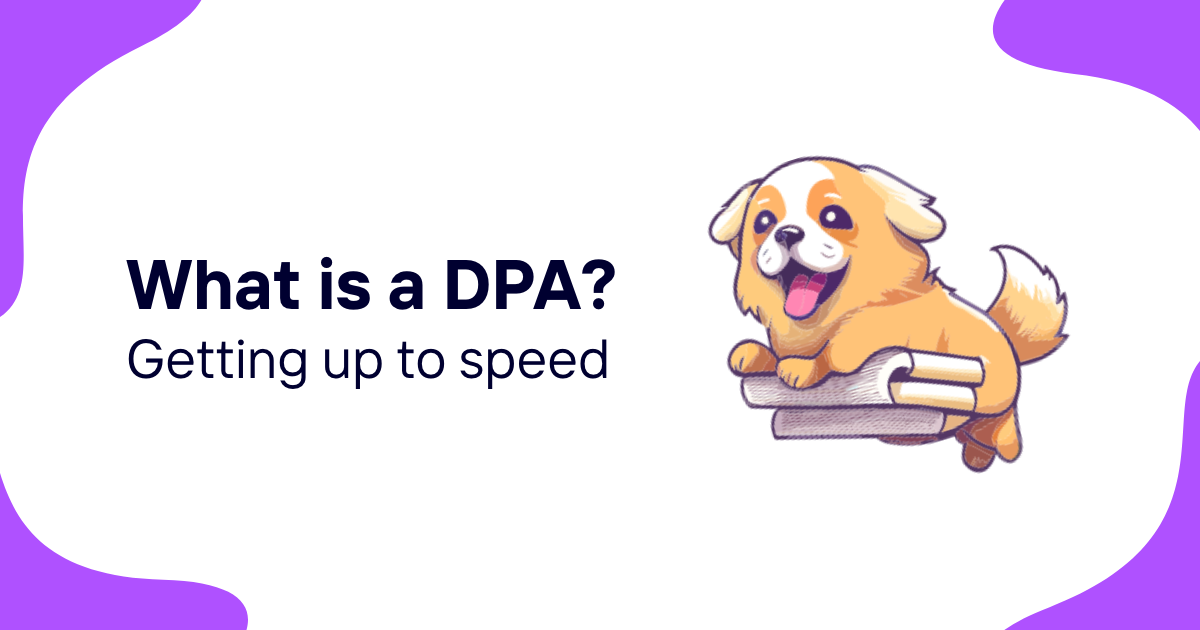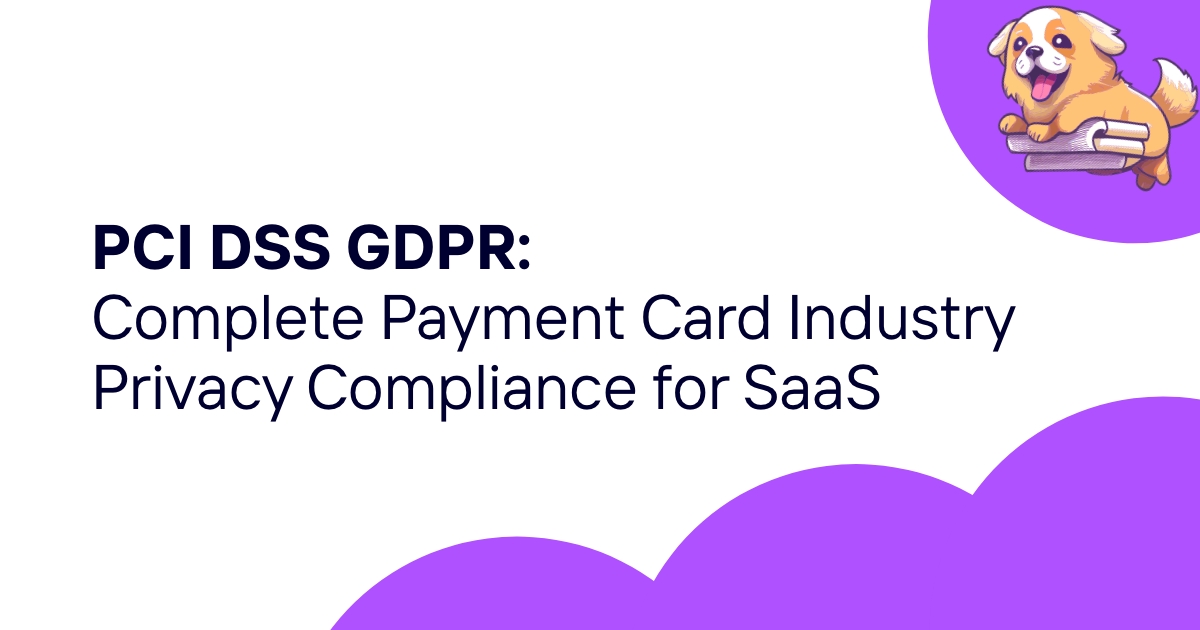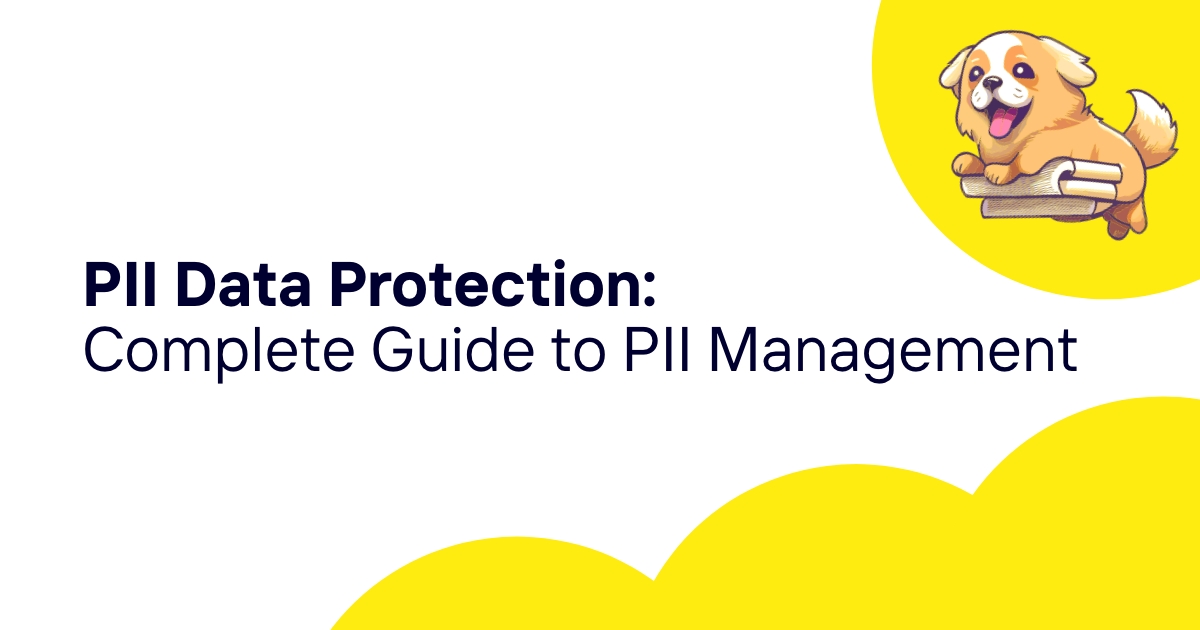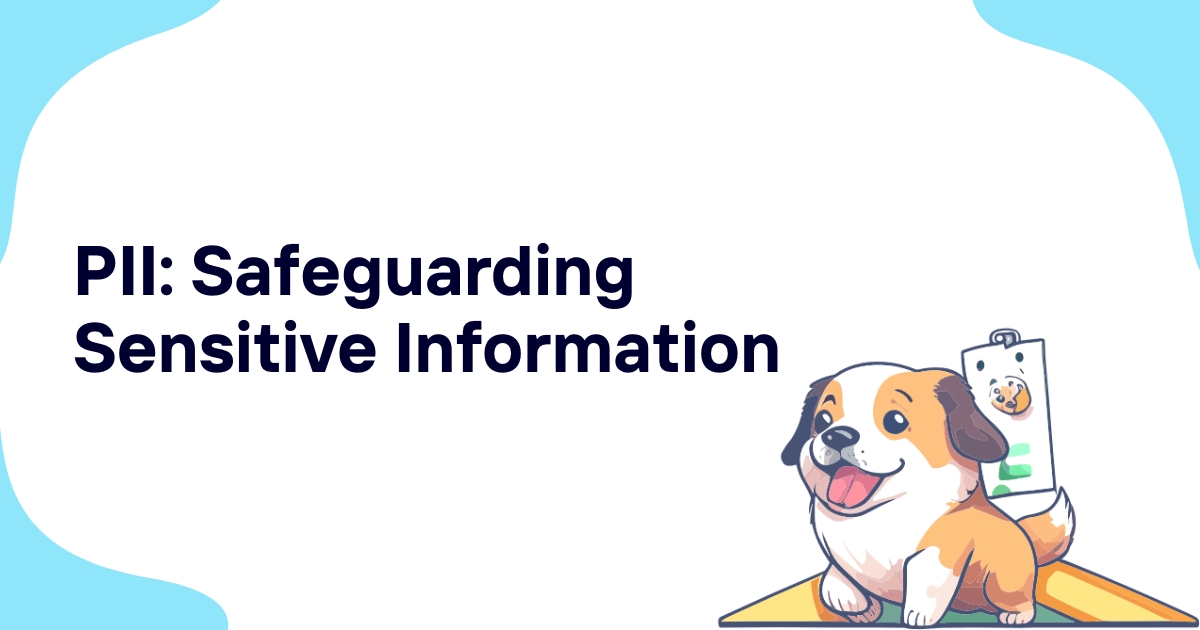Three acronyms dominate the data protection landscape, and most people can't tell them apart. PII, PHI, and PCI sound similar, but mixing them up can cost organizations millions in fines and lost customer trust.
Personal information comes in many forms. Some data helps identify individuals, while other information relates to their health records or payment details. Each type requires different protection methods and follows distinct regulatory frameworks.
The confusion becomes dangerous when businesses assume all sensitive data needs the same level of security. A payment processor treating credit card numbers like basic contact information will face regulatory penalties. Healthcare organizations mixing patient records with general customer data risk HIPAA violations.
Understanding these differences isn't just about compliance. It's about building trust with customers who expect their most sensitive information to receive appropriate protection.
Table of contents
- What is PII (personally identifiable information)?
- What is PCI (payment card industry) data?
- What is PHI (protected health information)?
- Key differences between PII, PCI, and PHI
- Regulatory frameworks and compliance requirements
- Common protection strategies for sensitive data
- Industry-specific considerations
- Data breach consequences and costs
- Best practices for data classification
- Technology solutions for data protection
- Future trends in data protection
What is PII (personally identifiable information)?
PII represents any information that can identify a specific individual, either by itself or when combined with other data points. This category serves as the foundation for most privacy regulations worldwide.
Direct identifiers immediately reveal someone's identity. Full names, Social Security numbers, passport numbers, and driver's license numbers fall into this category. These data points require minimal additional context to identify a person.
Indirect identifiers become identifying when combined with other information. A zip code alone might not identify someone, but pairing it with age and gender can narrow down the possibilities significantly. IP addresses, device identifiers, and location data often serve as indirect identifiers.
The context matters immensely with PII. A first name in a database of thousands provides little identifying power. But that same first name combined with a unique employee ID, department, and hire date creates a clear identification path.
Examples of PII
Common PII examples include these categories:
Direct identifiers:
- Full legal names
- Social Security numbers
- Driver's license numbers
- Passport numbers
- Biometric identifiers (fingerprints, retinal scans)
Indirect identifiers:
- Email addresses
- Phone numbers
- Home addresses
- Date of birth
- IP addresses
- Device identifiers
Contextual identifiers:
- Employee ID numbers
- Customer account numbers
- Usernames
- Photos that show faces
- Voice recordings
Organizations often underestimate how much PII they collect. Customer surveys, website analytics, and employee records contain numerous data points that qualify as personally identifiable information.
PII regulatory landscape
Multiple regulations govern PII protection, with requirements varying by jurisdiction and industry. The General Data Protection Regulation (GDPR) sets strict standards for European Union residents' data, regardless of where companies operate.
California's Consumer Privacy Act (CCPA) and Virginia's Consumer Data Protection Act (VCDPA) establish similar protections for US residents. These laws grant individuals rights to access, delete, and control their personal information.
Federal Trade Commission (FTC) guidelines provide additional oversight for US companies. The FTC enforces data protection through various consumer protection statutes, particularly focusing on unfair or deceptive practices.
Industry-specific regulations add another layer. Financial services must comply with Gramm-Leach-Bliley Act requirements, while educational institutions follow Family Educational Rights and Privacy Act (FERPA) guidelines.
What is PCI (payment card industry) data?
PCI refers to information related to payment card transactions, including credit and debit card details. This category encompasses more than just card numbers, extending to any data involved in payment processing.
The Payment Card Industry Data Security Standard (PCI DSS) governs how organizations handle this information. Major card brands (Visa, Mastercard, American Express, Discover) jointly developed these requirements to reduce fraud and protect cardholder data.
PCI DSS version 4.0 introduced stricter requirements for data encryption, access controls, and security monitoring. Organizations must implement multiple layers of protection to achieve and maintain compliance.
Types of PCI data
PCI information falls into several categories based on sensitivity and protection requirements:
Primary account numbers (PANs):
- Credit card numbers
- Debit card numbers
- Prepaid card numbers
Sensitive authentication data:
- Card verification values (CVV, CVC)
- PIN verification values
- Magnetic stripe data
- Chip authentication data
Supporting cardholder data:
- Cardholder names
- Expiration dates
- Service codes
Organizations must never store sensitive authentication data after transaction authorization. PANs and supporting data require encryption when stored and strict access controls throughout their lifecycle.
PCI DSS compliance framework
The PCI DSS framework consists of six main objectives designed to protect cardholder data:
| Objective | Key Requirements |
|---|---|
| Secure network architecture | Install firewalls, change default passwords |
| Protect cardholder data | Encrypt stored data, mask PANs when displayed |
| Maintain vulnerability management | Use updated antivirus software, patch systems regularly |
| Implement access controls | Restrict data access, assign unique IDs, limit physical access |
| Monitor networks | Track data access, test security systems regularly |
| Maintain information security policy | Document security procedures, conduct regular risk assessments |
Compliance validation depends on transaction volume. Level 1 merchants (over 6 million transactions annually) require annual on-site assessments by Qualified Security Assessors. Smaller merchants can complete self-assessment questionnaires.
Non-compliance penalties range from $5,000 to $100,000 per month, plus potential liability for fraudulent transactions. Card brands can also suspend merchant processing privileges, effectively ending the ability to accept card payments.
What is PHI (protected health information)?
PHI encompasses any health information that can be linked to a specific individual. This category receives the strongest legal protections in many jurisdictions, particularly in the United States under HIPAA.
The Health Insurance Portability and Accountability Act (HIPAA) defines PHI as individually identifiable health information held or transmitted by covered entities and their business associates. This includes past, present, and future physical or mental health conditions.
Electronic PHI (ePHI) represents the digital subset of PHI, subject to additional security requirements. Electronic health records, digital imaging, and health information exchanges all contain ePHI requiring specialized protection measures.
Components of PHI
PHI extends beyond obvious medical information to include any health-related data that could identify an individual:
Medical information:
- Diagnoses and treatment records
- Prescription medications
- Laboratory test results
- Medical imaging files
- Mental health notes
Administrative information:
- Medical record numbers
- Health plan beneficiary numbers
- Appointment schedules
- Billing information
- Insurance claims
Demographic information (when linked to health data):
- Names and addresses
- Birth dates
- Social Security numbers
- Phone numbers
- Email addresses
HIPAA identifies 18 specific identifiers that must be removed to create de-identified health information. Organizations can use de-identified data for research and analysis without HIPAA restrictions.
HIPAA compliance requirements
HIPAA establishes comprehensive requirements for PHI protection through multiple rules:
Privacy Rule requirements:
- Minimum necessary standard for data access
- Patient rights to access and amend records
- Written privacy policies and procedures
- Staff training on privacy practices
Security Rule requirements:
- Administrative safeguards (security officer, access management)
- Physical safeguards (facility controls, device controls)
- Technical safeguards (encryption, audit logs, transmission security)
Breach Notification Rule:
- Individual notification within 60 days
- HHS reporting within 60 days
- Media notification for large breaches
- Annual summary for smaller incidents
Penalties for HIPAA violations range from $100 to $50,000 per record, with annual maximums reaching $1.5 million per violation category. Criminal penalties can include fines up to $250,000 and imprisonment for up to 10 years.
Key differences between PII, PCI, and PHI
While these three data categories share some common characteristics, their differences shape how organizations must handle and protect them.
Scope and definition differences
PII serves as the broadest category, encompassing any information that identifies individuals. This includes everything from names and addresses to device identifiers and location data.
PCI focuses specifically on payment-related information. Credit card numbers, expiration dates, and transaction data fall under this category, along with associated cardholder information.
PHI restricts itself to health-related information that can identify individuals. Medical records, insurance claims, and health plan information comprise the core of this category.
The overlap between categories creates complexity. A patient's name and address constitute PII in most contexts. But when linked to medical records, the same information becomes PHI subject to HIPAA protections.
Regulatory oversight variations
Different agencies oversee each data type, creating varied enforcement approaches and penalty structures.
PII regulation:
- Multiple agencies (FTC, state attorneys general, data protection authorities)
- Varied penalty structures by jurisdiction
- Focus on consumer rights and business practices
PCI regulation:
- Card brand oversight through PCI Security Standards Council
- Industry-driven compliance requirements
- Financial penalties and processing privilege suspension
PHI regulation:
- Department of Health and Human Services oversight
- Federal civil and criminal penalties
- Individual state licensing board actions
This regulatory complexity means organizations often must satisfy multiple overlapping requirements for the same data elements.
Protection requirement differences
Each data type demands specific protection approaches based on its risk profile and regulatory framework.
PII protection focuses on access controls, data minimization, and user rights. Organizations must implement privacy-by-design principles and provide individuals control over their information.
PCI protection emphasizes encryption, network security, and transaction monitoring. Payment card data requires multiple layers of technical protection throughout its lifecycle.
PHI protection combines privacy and security requirements with healthcare-specific considerations. Medical information needs both technical safeguards and administrative controls to prevent unauthorized access.
Regulatory frameworks and compliance requirements
Organizations handling multiple data types must navigate overlapping regulatory requirements that can complement or conflict with each other.
International data protection laws
GDPR sets the global standard for data protection, applying to any organization processing EU residents' data regardless of location. The regulation covers all personal data, including PII and PHI when processed outside healthcare contexts.
Key GDPR requirements include:
- Lawful basis for processing personal data
- Data subject rights (access, rectification, erasure, portability)
- Privacy-by-design implementation
- Data breach notification within 72 hours
- Data Protection Impact Assessments for high-risk processing
Brazil's Lei Geral de Proteção de Dados (LGPD) mirrors many GDPR provisions while adapting to local legal traditions. Similar comprehensive privacy laws are emerging across Asia-Pacific and Latin American countries.
US federal and state regulations
The United States employs a sectoral approach to data protection, with different laws covering specific industries or data types.
Federal regulations:
- HIPAA for healthcare information
- Gramm-Leach-Bliley Act for financial services
- Children's Online Privacy Protection Act (COPPA) for children under 13
- Fair Credit Reporting Act for consumer credit information
State privacy laws:
- California Consumer Privacy Act (CCPA) and California Privacy Rights Act (CPRA)
- Virginia Consumer Data Protection Act (VCDPA)
- Colorado Privacy Act (CPA)
- Connecticut Data Privacy Act (CTDPA)
State laws typically provide broader individual rights than federal sector-specific regulations, creating additional compliance layers for multi-state operations.
Industry-specific standards
Beyond government regulations, industry bodies establish additional data protection requirements.
Payment Card Industry standards apply to all organizations accepting card payments, regardless of size or industry. PCI DSS requirements become contractual obligations through merchant agreements with payment processors.
Healthcare accreditation bodies like The Joint Commission incorporate data protection requirements into hospital accreditation standards. These requirements often exceed HIPAA minimums.
Financial services face additional oversight from banking regulators who examine data protection practices during regular examinations. Cryptocurrency and fintech companies encounter evolving regulatory expectations as these sectors mature.
Common protection strategies for sensitive data
Effective data protection requires layered security approaches that address technical, administrative, and physical controls.
Technical safeguards
Encryption serves as the foundation for sensitive data protection. Data should be encrypted both at rest and in transit using industry-standard algorithms. Advanced Encryption Standard (AES) 256-bit encryption provides robust protection for stored data.
Access controls limit who can view or modify sensitive information. Role-based access control (RBAC) systems assign permissions based on job functions, while attribute-based access control (ABAC) provides more granular permission management.
Audit logging tracks all access to sensitive data, creating accountability and supporting incident response efforts. Logs should capture user identities, timestamps, actions performed, and data accessed.
Data loss prevention (DLP) systems monitor data movement and block unauthorized transfers. These systems can identify sensitive data patterns and prevent accidental or malicious data exposure.
Network segmentation isolates sensitive data systems from general network traffic. This approach limits attack surfaces and contains potential breaches.
Administrative controls
Written policies establish organizational expectations for data protection. Policies should address data classification, handling procedures, access management, and incident response.
Staff training ensures employees understand their data protection responsibilities. Training should be role-specific and updated regularly to address emerging threats.
Background checks for employees accessing sensitive data help identify potential risks before granting access privileges. The level of screening should correspond to data sensitivity and access levels.
Incident response procedures enable rapid reaction to data breaches or security incidents. Response plans should include notification requirements, containment procedures, and recovery steps.
Vendor management programs assess third-party data protection practices. Organizations remain responsible for data protection even when using external service providers.
Physical security measures
Facility access controls prevent unauthorized physical access to systems containing sensitive data. This includes locked server rooms, badge access systems, and visitor escort requirements.
Workstation security protects endpoints that access sensitive data. Screen locks, cable locks, and clean desk policies prevent unauthorized data access.
Media disposal procedures ensure sensitive data cannot be recovered from discarded storage devices. Cryptographic erasure or physical destruction may be required depending on data sensitivity.
Environmental controls protect systems from physical threats like fire, flooding, and temperature extremes. Backup power systems ensure data protection systems remain operational during outages.
Industry-specific considerations
Different industries face unique challenges when protecting PII, PCI, and PHI data based on their operational requirements and regulatory environments.
Healthcare organizations
Healthcare providers handle all three data types regularly, creating complex compliance requirements. Patient records contain PHI, billing systems process PCI data, and employee records include PII.
Electronic Health Record (EHR) systems must meet HIPAA security requirements while remaining accessible for patient care. This balance requires sophisticated access controls and audit capabilities.
Telemedicine platforms introduce additional security considerations. Video consultations, remote monitoring devices, and mobile health applications all create new attack surfaces for PHI exposure.
Healthcare data sharing for research and public health purposes requires careful de-identification procedures. Organizations must remove or modify identifying elements while preserving data utility.
Medical device security presents unique challenges as connected devices collect and transmit PHI. Legacy devices often lack modern security features, requiring network-based protection strategies.
Financial services
Banks and credit unions handle extensive PCI and PII data while facing stringent regulatory oversight from multiple agencies.
Online banking platforms must protect account information and transaction data while providing convenient customer access. Multi-factor authentication and behavioral analytics help balance security and usability.
Payment processors face PCI DSS requirements along with anti-money laundering and know-your-customer regulations. These overlapping requirements often mandate data retention that conflicts with data minimization principles.
Cryptocurrency exchanges handle both traditional financial data and blockchain-specific information. Regulatory uncertainty creates challenges for compliance program development.
Financial advisory services manage sensitive client information including investment details, estate planning documents, and insurance records. This information often receives less regulatory attention than banking data but requires similar protection.
Retail and e-commerce
Retail organizations collect customer PII for marketing and PCI data for payment processing. Seasonal traffic spikes and promotional campaigns create additional security challenges.
Point-of-sale systems in physical stores must meet PCI DSS requirements while supporting fast transaction processing. End-to-end encryption helps protect cardholder data throughout the payment process.
E-commerce platforms face unique challenges from automated attacks and fraudulent transactions. Bot detection and fraud scoring systems help identify suspicious activities.
Customer loyalty programs collect extensive personal information for marketing purposes. These programs must balance data collection benefits with privacy risks and regulatory compliance.
Third-party payment processors can reduce PCI DSS scope for retailers but create vendor risk management requirements. Due diligence and contract management become critical for data protection.
Data breach consequences and costs
Data breaches involving PII, PCI, or PHI can devastate organizations through financial penalties, legal liability, and reputation damage.
Financial impact analysis
The average cost of a data breach reached $4.45 million globally, with significant variations based on data types involved and organizational preparedness.
Direct costs include:
- Regulatory fines and penalties
- Legal fees and settlement costs
- Forensic investigation expenses
- Credit monitoring services for affected individuals
- System remediation and security improvements
Indirect costs include:
- Lost business and customer churn
- Increased insurance premiums
- Regulatory oversight and compliance monitoring
- Brand reputation damage
- Stock price impacts for public companies
Healthcare breaches cost an average of $9.77 million per incident, reflecting the sensitive nature of PHI and strict HIPAA penalties. Financial services breaches average $5.72 million, while retail breaches cost approximately $3.28 million.
Regulatory penalty structures
Penalties vary significantly based on violation severity, organizational size, and compliance history.
HIPAA penalties range from $100 to $50,000 per record with annual maximums of:
- $25,000 for identical violations (corrected within 30 days)
- $100,000 for violations due to willful neglect but corrected
- $250,000 for violations due to willful neglect and not corrected
- $1,500,000 maximum annual penalty per violation category
GDPR fines can reach:
- €10 million or 2% of annual global revenue (whichever is higher)
- €20 million or 4% of annual global revenue for severe violations
PCI DSS penalties include:
- $5,000 to $100,000 monthly fines during non-compliance periods
- Liability for fraudulent transactions
- Potential loss of payment processing privileges
State privacy law penalties vary but generally range from $100 to $7,500 per consumer record, with some states allowing higher penalties for violations involving children or sensitive data.
Legal and reputational consequences
Class action lawsuits frequently follow major data breaches, with settlement amounts ranging from thousands to hundreds of millions of dollars. Legal costs continue for years as litigation progresses through court systems.
Regulatory investigations can last months or years, requiring significant management attention and resources. Organizations may face ongoing monitoring requirements and consent decrees limiting business operations.
Customer trust erosion affects long-term business prospects beyond immediate financial impacts. Studies show 65% of consumers lose trust in organizations following data breaches, with 27% ending business relationships entirely.
Insurance coverage may not fully protect against all breach-related costs. Cyber insurance policies often exclude regulatory fines and may have coverage limits below actual breach costs.
Best practices for data classification
Effective data protection begins with accurate identification and classification of sensitive information throughout an organization.
Automated discovery tools
Modern data discovery solutions use machine learning and pattern recognition to identify PII, PCI, and PHI across diverse storage systems. These tools scan structured databases, unstructured file shares, email systems, and cloud storage platforms.
Content analysis examines file contents rather than relying on names or locations. Regular expressions, statistical analysis, and contextual clues help identify sensitive data regardless of how it's stored or labeled.
Continuous monitoring tracks data movement and identifies new sensitive data as it enters organizational systems. This approach catches information that might be missed during periodic scans.
Integration with data loss prevention systems enables automatic policy enforcement once sensitive data is identified. Classification tags can trigger encryption, access controls, or other protective measures.
Manual classification procedures
Human review remains important for complex data types or unusual formats that automated tools might miss. Subject matter experts can identify context-specific sensitivities that algorithms overlook.
Classification workflows should involve data owners who understand business purposes and regulatory requirements. IT teams can provide technical classification capabilities, but business teams must define protection needs.
Regular classification reviews account for changing data sensitivity as business contexts evolve. Information that starts as non-sensitive might become sensitive as additional data elements are added.
Exception handling procedures address edge cases where automated classification produces incorrect results. Appeal processes allow data owners to request reclassification when business needs conflict with automated decisions.
Data inventory management
Comprehensive data inventories track all sensitive information locations, formats, and protection status. These inventories support compliance reporting and incident response planning.
Inventory elements should include:
- Data types and sensitivity levels
- Storage locations and system owners
- Access controls and encryption status
- Retention periods and disposal schedules
- Third-party sharing arrangements
- Regulatory requirements applicable to each data set
Regular inventory updates reflect system changes, new data sources, and evolving business needs. Automated tools can support inventory maintenance, but human oversight ensures accuracy and completeness.
Data mapping exercises trace sensitive information flows throughout organizational systems. Understanding how data moves helps identify protection gaps and compliance risks.
Technology solutions for data protection
Organizations need integrated technology platforms that address the full lifecycle of sensitive data protection.
Encryption and key management
Enterprise key management systems provide centralized control over encryption keys used to protect sensitive data. These systems support key generation, distribution, rotation, and revocation across diverse applications and storage systems.
Database encryption solutions protect structured data at rest while maintaining query performance. Transparent data encryption operates at the storage level, while column-level encryption provides granular protection for specific fields.
Application-layer encryption gives developers control over what data gets encrypted and how keys are managed. This approach works well for cloud applications and distributed systems where database-level encryption may not be practical.
Tokenization replaces sensitive data with non-sensitive tokens that maintain referential integrity. Payment processors often use tokenization to reduce PCI DSS scope while preserving transaction processing capabilities.
Identity and access management
Modern IAM systems provide fine-grained control over who can access sensitive data and under what circumstances. These systems integrate with existing directory services while adding policy enforcement capabilities.
Zero trust architectures assume no implicit trust and verify every access request. This approach works particularly well for protecting sensitive data that might be accessed from various locations and devices.
Privileged access management (PAM) solutions control administrative access to systems containing sensitive data. Session recording and monitoring capabilities provide audit trails for high-risk activities.
Identity governance platforms help manage user lifecycle processes, ensuring access rights remain appropriate as job roles change. Automated provisioning and deprovisioning reduce the risk of inappropriate access.
Monitoring and analytics
Security information and event management (SIEM) platforms collect and analyze security logs from systems handling sensitive data. Machine learning capabilities help identify unusual access patterns that might indicate breaches.
User behavior analytics (UBA) establish baselines for normal data access patterns and alert on anomalous activities. These systems can identify insider threats and compromised accounts.
Data activity monitoring (DAM) solutions focus specifically on database and file system access. These tools provide detailed visibility into who accessed what data and when.
Cloud access security brokers (CASBs) extend monitoring capabilities to cloud-based systems and applications. These solutions help maintain visibility and control as organizations adopt cloud services.
Future trends in data protection
Emerging technologies and regulatory developments will reshape how organizations protect PII, PCI, and PHI in coming years.
Artificial intelligence and machine learning
AI-powered data discovery tools will become more accurate at identifying sensitive data in complex formats and contexts. Natural language processing capabilities will help classify unstructured text documents and communication records.
Automated policy enforcement will use machine learning to make real-time decisions about data access requests. These systems will consider multiple factors including user behavior, data sensitivity, and business context.
Anomaly detection algorithms will become more sophisticated at identifying subtle indicators of data breaches or insider threats. Behavioral baselines will adapt continuously as normal patterns evolve.
Privacy-preserving machine learning techniques like differential privacy and federated learning will enable data analysis while protecting individual privacy. These approaches will be particularly valuable for healthcare and financial services.
Quantum computing implications
Quantum computing threatens current encryption standards, requiring migration to quantum-resistant algorithms. Organizations must begin planning for this transition to maintain long-term data protection.
Post-quantum cryptography standards are emerging from standards bodies like NIST. Early adoption of quantum-resistant algorithms will provide protection against future quantum threats.
Quantum key distribution offers theoretically perfect security for data transmission. While currently impractical for most organizations, this technology may become viable for high-value data protection.
Hybrid quantum-classical systems will likely emerge as intermediate solutions, providing enhanced security while maintaining compatibility with existing infrastructure.
Regulatory evolution
Privacy regulations continue expanding globally, with new laws emerging in developing markets. Organizations will need to adapt compliance programs to address diverse and sometimes conflicting requirements.
Sector-specific regulations are becoming more detailed and prescriptive. Healthcare, financial services, and telecommunications face increasingly specific requirements that go beyond general privacy laws.
Cross-border data transfer restrictions are becoming more complex as countries implement data localization requirements. Organizations will need sophisticated data governance systems to track and control international data flows.
Enforcement actions are becoming more aggressive and sophisticated. Regulators are using advanced analytical techniques to identify compliance violations and assess appropriate penalties.
The complexity of protecting PII, PCI, and PHI continues growing as organizations collect more diverse data types and face expanding regulatory requirements. Success requires comprehensive strategies that address technical, administrative, and physical controls while maintaining operational efficiency.
Organizations that invest in robust data protection programs benefit from reduced regulatory risk, improved customer trust, and competitive advantages in privacy-conscious markets. The cost of prevention remains far lower than the cost of breaches and compliance failures.
Compliance software platforms like ComplyDog help organizations manage these complex requirements through automated data discovery, policy management, and compliance monitoring. These integrated solutions provide the visibility and control necessary to protect sensitive data while meeting diverse regulatory obligations across multiple jurisdictions and data types.


